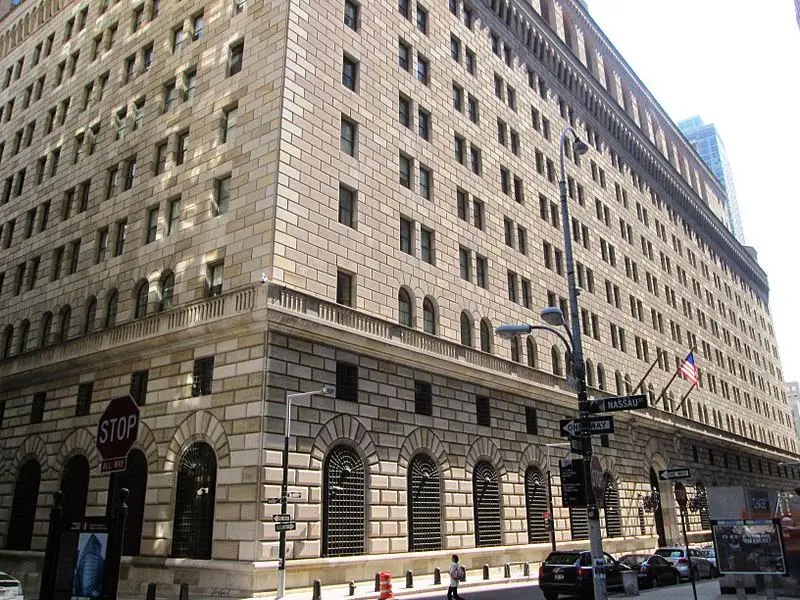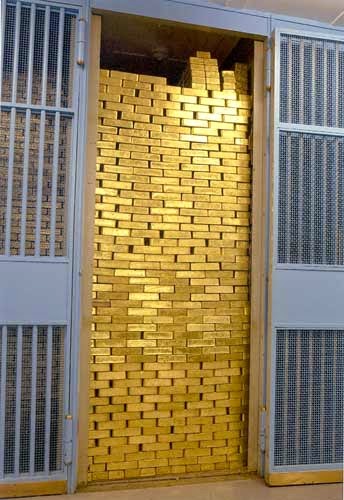Gold is one of the most prized elements on the planet. It has been used throughout history as a sign of power and wealth, adorned in jewelry, and even used in practical applications that use its anti-corrosive properties. But since there isn’t much of it sitting in the ground, it has become a rare commodity, and it has to be held safe and secure. There is one place where the most gold on earth sits, and it is the largest gold vault in the world.
If you had to guess where that place was, your first choice might be the famous Fort Knox, in Fort Knox, Kentucky. That gold-depository is huge, but there is one that is even bigger. It sits in a place you might not think would be a usual site to store gold, but this place is a fortress. On the southern tip of Manhattan in New York City, the vault of the Federal Reserve Bank of New York sits buried five-stories underneath the city streets. Its vault holds roughly $350 billion worth in gold, but this has fluctuated in the previous six years. Its exact amount is not known. In comparison, Fort Knox holds approximately $130 billion in gold.

The gold inside the New York Federal Reserve Bank holds 25% of the world’s gold reserves, and much of the gold that resides there doesn’t even belong to the U.S. government. There are around 530,000 gold bars as of 2012, and while about 5% of the gold is the property of the U.S., the rest belongs to a host of other nations’ central banks. Forty-eight foreign banks and 12 international organizations use the vault to store their gold reserves. These entities are allowed to store their gold for free, but once they want to withdraw a bar, it costs them $1.75. Sounds like a pretty good deal, since where the bars are stored is about the most secure place on earth.
The Federal Reserve building looks just like any other building in the district, but the windows from the first to third floors are closed with iron bars. Security is understandably tight, and armed guards patrol the outside of the facility constantly. The vault is 80-feet underground and 50-feet below sea level. It was placed on bedrock, and it’s surrounded by rock on each of each its sides. The walls of the vault are made of thick, steel-reinforced concrete.
The only way to get into the vault is by going through a passage that is a 90-ton steel cylinder, which is also encased in 140-tons of concrete and steel. When the area is closed, it is airtight, and four steel rods lock into holes in the cylinder. Once that happens, it can’t be opened until the next business day.
If that wasn’t enough, the vault is monitored inside and out, 24-hours a day, by security cameras and motion sensors. Three people must be present anytime gold is moved, or a compartment is opened in the vault. Two members of the New York Fed gold vault staff and one employee from the New York Fed internal audit staff are responsible for any movement of gold and if anything needs to be done in the vault. Nothing can go on without all three of them being present.
When gold comes into the vault, it is moved from the street to the basement by elevator, the bars are weighed, and all markings are inspected to make sure that whatever comes in leaves in the exact same condition. The bars are then moved to a compartment in the vault. Overall there are 122 compartments, and each compartment belongs to a single account holder. After the gold has been deposited, the compartments are padlocked, two combination locks are added, and finally, the compartment is fixed with an auditor’s seal.
The beginnings of the gold storage at the New York Fed began after World War II when countries were looking for a safe haven for their gold reserves. Its peak was in 1973 when the vault held over 12,000 tons of gold, almost double the size it is now. The gold bars were the well-known rectangular shape prior to 1986, but now the bars are cast in the international standard of the shape of a trapezoid. It’s interesting to note that the bars are not 100% gold because they would be too “soft,” or malleable, and wouldn’t keep their shape when stacked or stored. They contain trace amounts of at least one other metal to help them keep their shape.
So if you’re looking to store your vast amount of gold deposits, I have bad news. The New York Reserve Bank doesn’t store gold for private individuals or companies. You’ll have to find somewhere else, but you can take a tour of the vault if you sign up months in advance.
Sources: Federal Reserve Bank, ABC News



